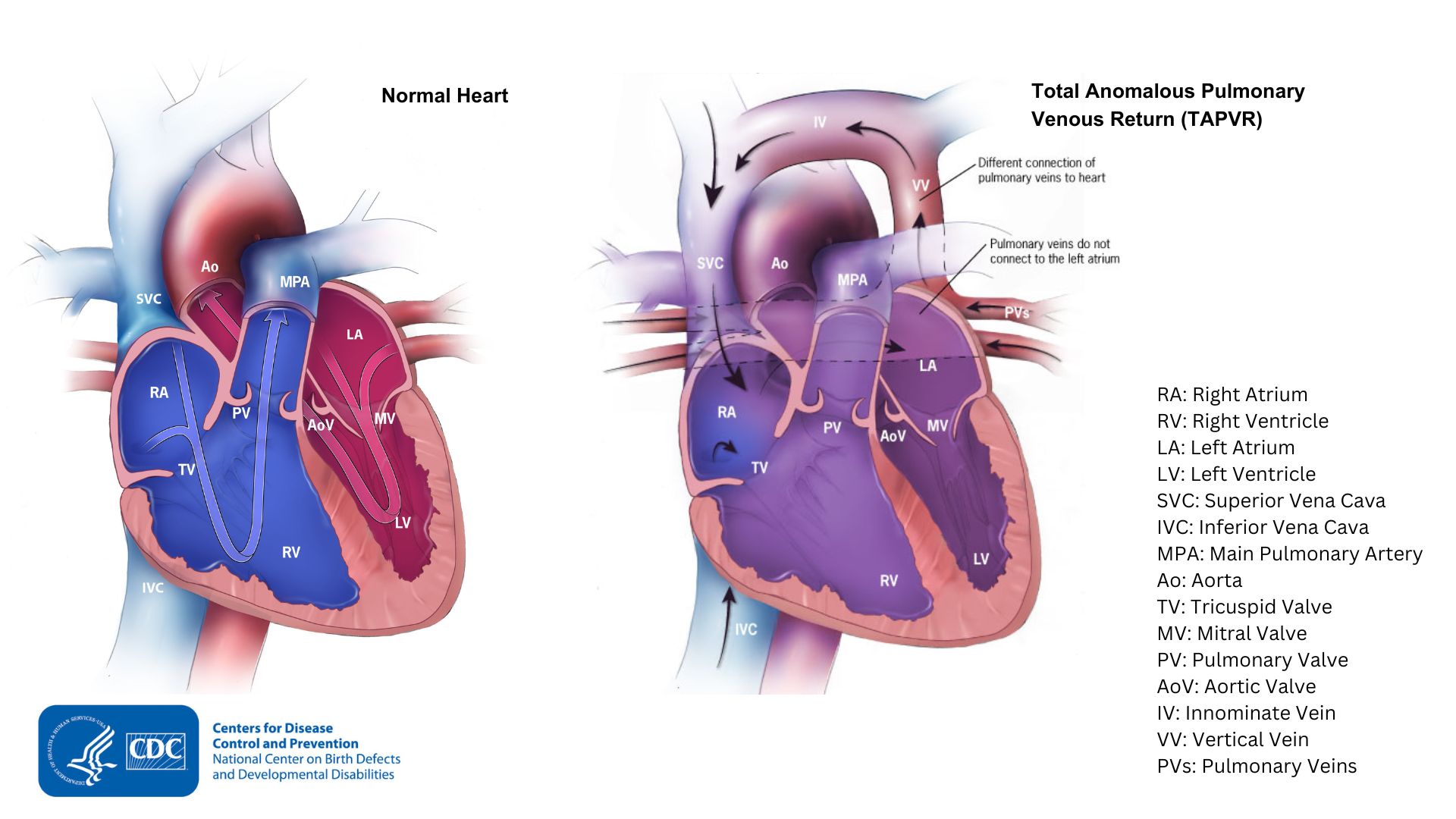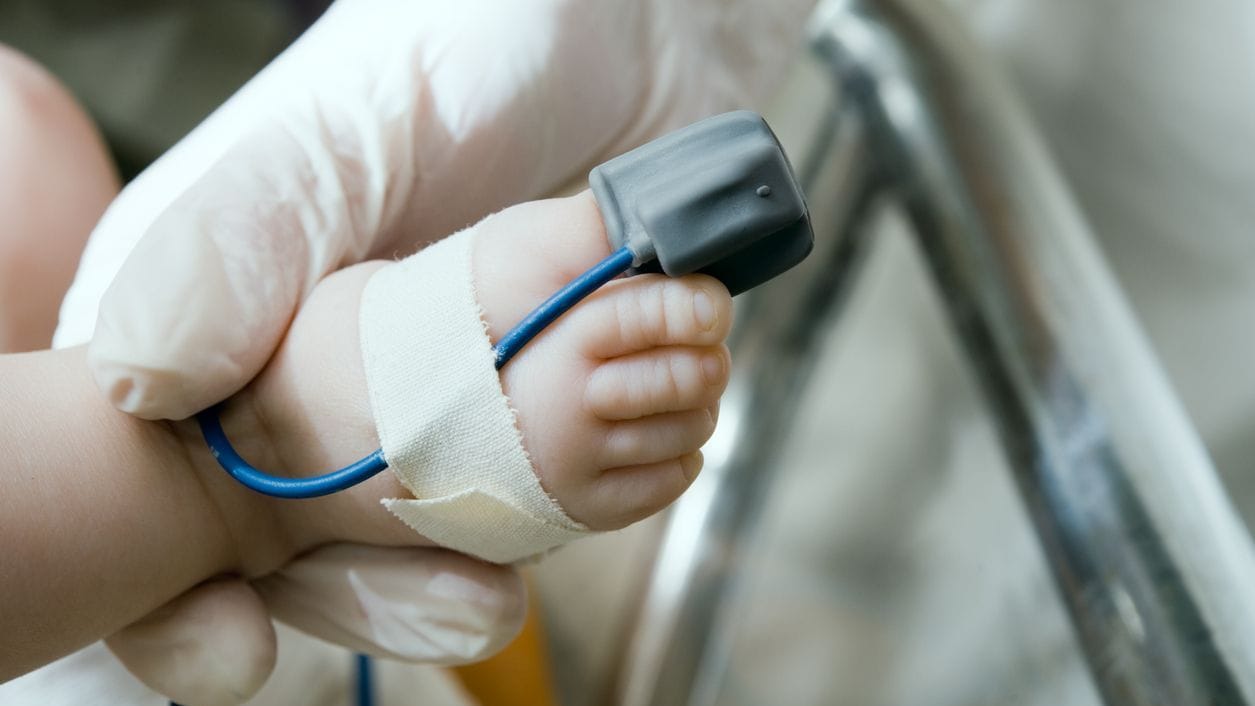Key points
- Total anomalous pulmonary venous return (pronounced TOHT-l uh-NOM-uh-luh-s PUHL-muh-ner-ee VEE-nuh-s ri-TURN) or T-A-P-V-R is a congenital heart defect.
- Congenital means present at birth.
- TAPVR occurs when the pulmonary veins connect to the heart by way of an abnormal (anomalous) connection.
- People with this condition need routine checkups with a heart doctor to stay as healthy as possible as they get older.

What it is
TAPVR occurs when the pulmonary veins bringing blood back from the lungs do not connect to the left atrium. Instead, they go to the heart by way of an abnormal (anomalous) connection.
In a baby with TAPVR, oxygen-rich blood from the lungs returns to the right side of the heart. Here, oxygen-rich blood mixes with oxygen-poor blood. This causes the baby to get less oxygen than is needed to the body.
To survive with this defect, babies with TAPVR usually have an atrial septal defect (ASD). An ASD is a hole between the right atrium and the left atrium. An ASD helps the mixed blood get to the left side of the heart. From there, the blood is pumped out to the rest of the body. Some children can have other heart defects along with TAPVR, aside from the ASD.
A baby with TAPVR may need surgery or other procedures soon after birth. Therefore, TAPVR is considered a critical congenital heart defect (critical CHD).

In a related defect, Partial Anomalous Pulmonary Venous Return (PAPVR), not all of the veins have an abnormal connection. There are some abnormal connections, but one or more of the veins return normally to the left atrium. Therefore, PAPVR is not as critical as TAPVR.
Occurrence
About 1 in every 7,809 babies in the United States are born with TAPVR[1]. This means that about 504 babies are born with TAPVR each year.
Types
There are different types of TAPVR, based on where the pulmonary veins connect:
Supracardiac: In supracardiac TAPVR, pulmonary veins come together and form an abnormal connection above the heart to the superior vena cava. The superior vena cava is a main blood vessel. It brings oxygen-poor blood from the upper part of the body to the heart. In this type, a mixture of oxygen-poor and oxygen-rich blood returns to the right atrium through the superior vena cava.
Cardiac: In cardiac TAPVR, the pulmonary veins meet behind the heart and connect to the right atrium. The coronary sinus is a vein that helps bring oxygen-poor blood from the heart muscle back to the heart. The coronary sinus helps connect the pulmonary veins to the right atrium in this type of TAPVR.
Infracardiac: In infracardiac TAPVR, the pulmonary veins come together and form abnormal connections below the heart. An oxygen-poor blood and oxygen-rich blood mixture returns to the right atrium from the liver's veins and the inferior vena cava. The inferior vena cava is the main blood vessel that brings oxygen-poor blood from the lower body to the heart.
Symptoms
Symptoms of TAPVR usually occur at birth or very soon afterwards. Infants with TAPVR can have a bluish looking skin color, called cyanosis, because their blood doesn't carry enough oxygen. Infants with TAPVR or other conditions causing cyanosis can have symptoms such as:
- Problems breathing
- Weak pulse
- Ashen or bluish skin color
- Poor feeding
- Extreme sleepiness
Risk factors
The causes of TAPVR among most babies are unknown. Some babies have heart defects because of changes in their genes or chromosomes. A combination of genes and other risk factors may increase the risk for TAPVR. These factors can include things in a mother's environment, what she eats or drinks, or the medicines she uses.
Testing and diagnosis
TAPVR and PAPVR might be diagnosed during pregnancy, but more often these defects are diagnosed soon after a baby is born.
During pregnancy
During pregnancy, an ultrasound, a tool that creates pictures of the baby, may detect TAPVR. If the health care provider suspects TAPVR from the ultrasound findings, they can request a fetal echocardiogram to confirm the diagnosis. A fetal echocardiogram is a more detailed ultrasound of the baby's heart.
However, TAPVR is not commonly detected during pregnancy. It is hard for doctors to see the pulmonary veins on the prenatal screening tests. This is because not much blood goes to the lungs before the baby is born. It is easier to detect TAPVR after birth when blood is flowing to the lungs and returning to the heart.
After the baby is born
During a physical exam, a doctor may observe symptoms or hear a heart murmur. If a doctor suspects a problem, the health care provider might request additional tests to confirm the diagnosis. The most common test is an echocardiogram, which is an ultrasound of the heart. Cardiac catheterization also can confirm the diagnosis by showing which blood vessels are abnormally attached. Other tests to make the diagnosis include chest x-rays and other medical tests.
TAPVR can also be detected with newborn pulse oximetry screening. Low levels of oxygen in the blood can be a sign of a critical CHD like TAPVR. Newborn screening using pulse oximetry can identify some infants with TAPVR before they show any symptoms.

Treatment
Babies with TAPVR will need surgery to repair the defect. The age at which the surgery is done depends on:
- How sick the child is
- The specific structure of the abnormal connections
The goal of surgical repair of TAPVR is to restore normal blood flow through the heart. To repair this defect, doctors usually:
- Connect the pulmonary veins to the left atrium
- Close off any abnormal connections between blood vessels
- Close the atrial septal defect
- Stallings EB, Isenburg JL, Rutkowski RE et al; for the National Birth Defects Prevention Network. National population-based estimates for major birth defects, 2016–2020. Birth Defects Res. 2024;116(1):https://doi.org/10.1002/bdr2.2301
